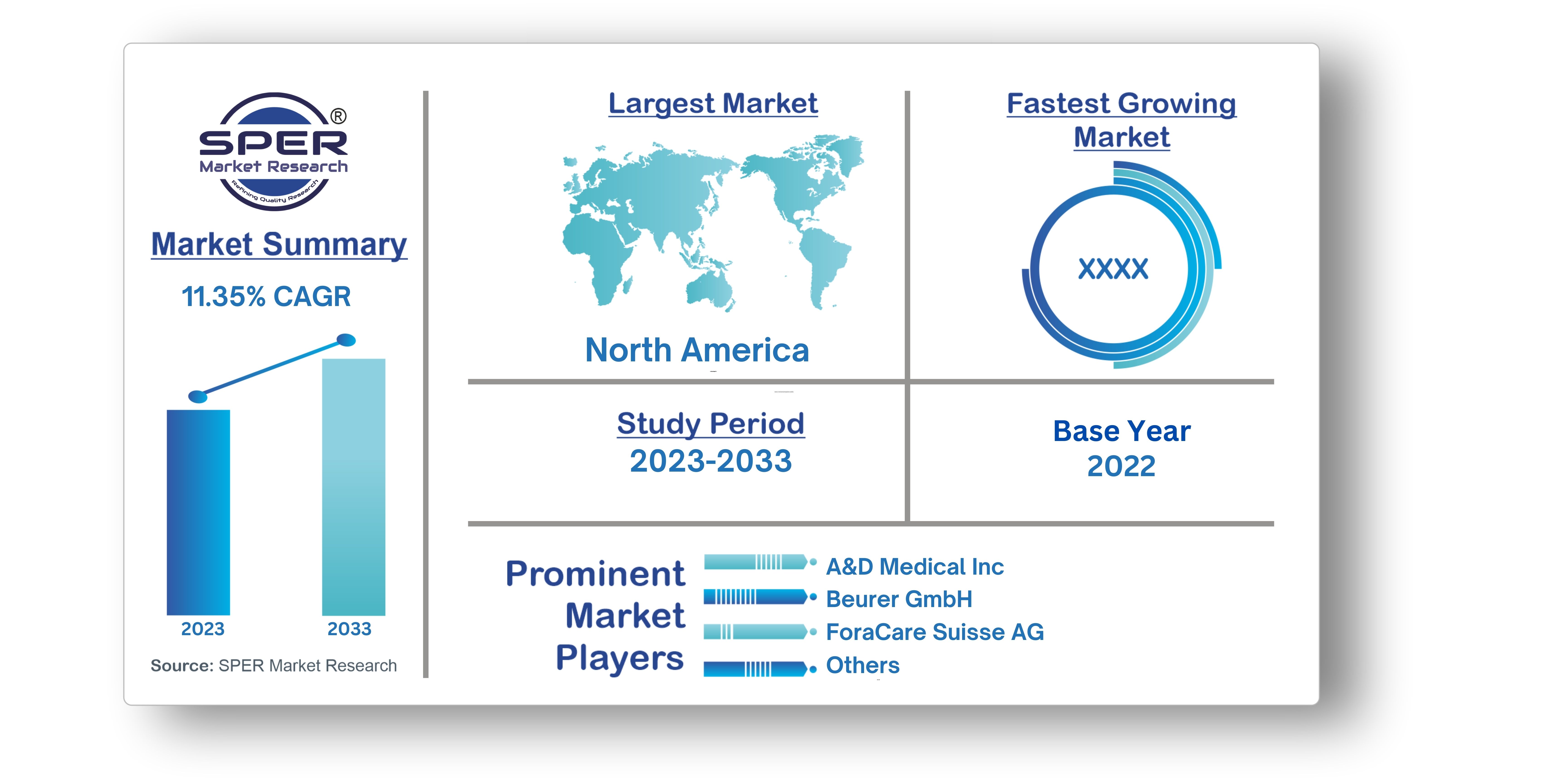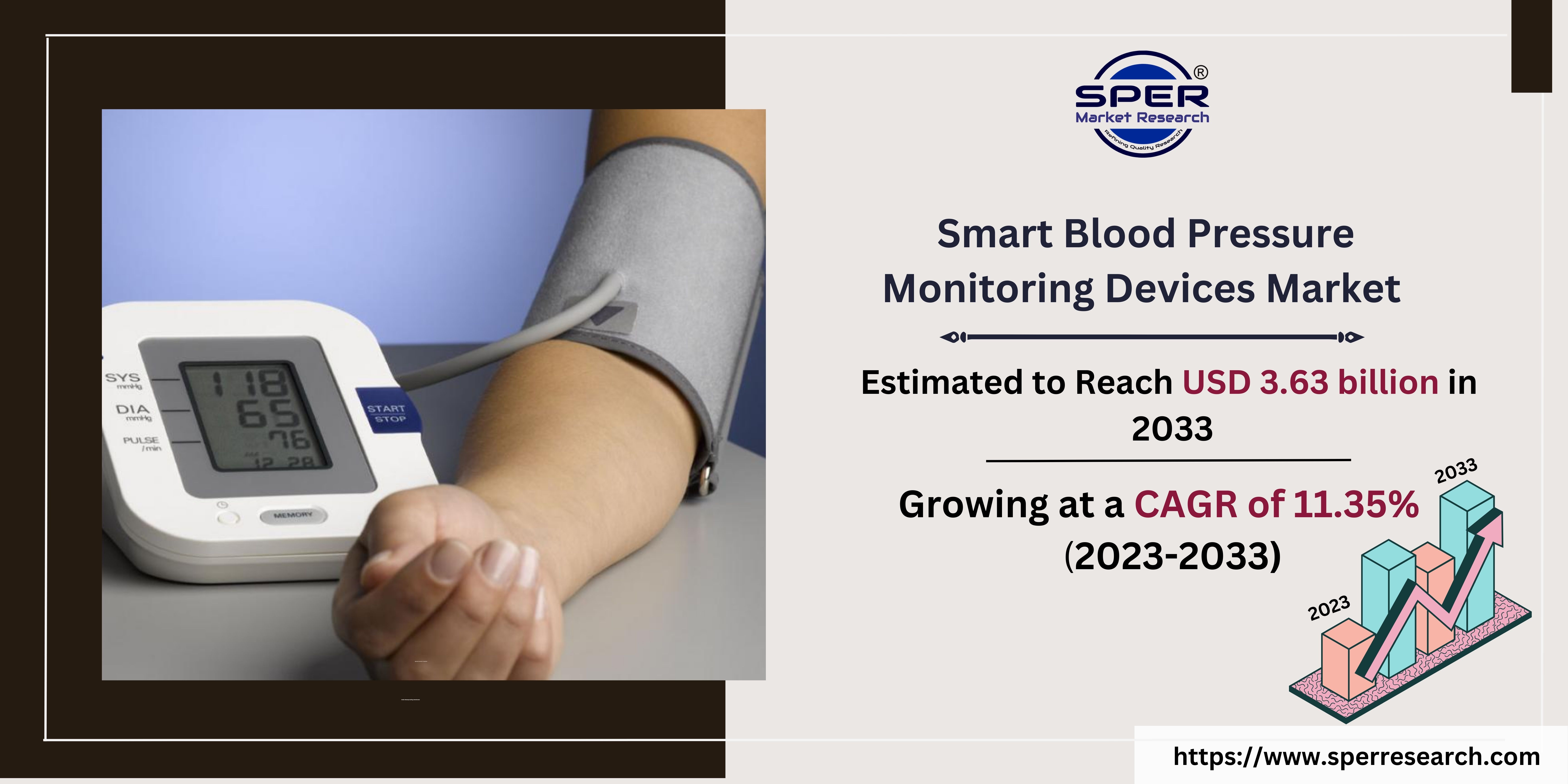
Smart Blood Pressure Monitoring Devices Market Growth, Trends, Size, Share, Scope and Future Trends
Smart Blood Pressure Monitoring Devices Market Size- By Product, By Size, By Distribution Channel- Regional Outlook, Competitive Strategies and Segment Forecast to 2033
| Published: Apr-2023 | Report ID: HLCA2330 | Pages: 1 - 236 | Formats*: |
| Category : Healthcare | |||
- Omron Healthcare launched its first remote patient monitoring service at CES 2021 in January 2021, along with new digital health technologies to improve patient-to-physician communication and enable more active management of hypertension.
- In Body Pvt. Ltd. has announced the release of the BP 170, an automatic blood pressure monitor. Individuals can use these devices to self-record and track major health parameters without visiting their doctor.


| Report Metric | Details |
| Market size available for years | 2019-2033 |
| Base year considered | 2022 |
| Forecast period | 2023-2033 |
| Segments covered | By Type, By Technology |
| Regions covered | North America, Asia-Pacific, Latin America, Middle East & Africa and Europe. |
| Companies Covered | A&D Medical Inc., Beurer GmbH, ForaCare Suisse AG, iHealth Labs Inc., Kaz Inc., Koninklijke Philips N.V., Microlife AG, Omron Healthcare, Inc, Qardio, Inc. |
- Healthcare providers
- Hospitals
- Clinics
- Pharmacies
- Patients
| By Type: |
|
| By Technology: |
|
- Global Smart Blood Pressure Monitoring Devices Market Size (FY’2023-FY’2033)
- Overview of Global Smart Blood Pressure Monitoring Devices Market
- Segmentation of Global Smart Blood Pressure Monitoring Devices Market By Type (Upper Arm Blood Pressure Monitor, Wrist Blood Pressure Monitor, Finger Blood Pressure Monitor)
- Segmentation of Global Smart Blood Pressure Monitoring Devices Market By Technology (Wi-Fi Based/4G, Bluetooth Based)
- Statistical Snap of Global Smart Blood Pressure Monitoring Devices Market
- Expansion Analysis of Global Smart Blood Pressure Monitoring Devices Market
- Problems and Obstacles in Global Smart Blood Pressure Monitoring Devices Market
- Competitive Landscape in the Global Smart Blood Pressure Monitoring Devices Market
- Impact of COVID-19 and Demonetization on Global Smart Blood Pressure Monitoring Devices Market
- Details on Current Investment in Global Smart Blood Pressure Monitoring Devices Market
- Competitive Analysis of Global Smart Blood Pressure Monitoring Devices Market
- Vital Players in the Global Smart Blood Pressure Monitoring Devices Market
- SWOT Analysis of Global Smart Blood Pressure Monitoring Devices Market
- Global Smart Blood Pressure Monitoring Devices Market Future Outlook and Projections (FY’2023-FY’2033)
- Recommendations from Analyst
1.1. Scope of the report1.2. Market segment analysis
2.1 Research data source2.1.1 Secondary data2.1.2 Primary data2.1.3 SPER’s internal database2.1.4 Premium insight from KOL’s2.2 Market size estimation2.2.1 Top-down and Bottom-up approach2.3 Data triangulation
4.1. Driver, Restraint, Opportunity and Challenges analysis4.1.1 Drivers4.1.2 Restraints4.1.3 Opportunities4.1.4 Challenges4.2. COVID-19 Impacts of the Global Smart Blood Pressure Monitoring Devices Market
5.1. SWOT analysis5.1.1 Strengths5.1.2 Weaknesses5.1.3 Opportunities5.1.4 Threats5.2. PESTEL analysis5.2.1 Political landscape5.2.2 Economic landscape5.2.3 Social landscape5.2.4 Technological landscape5.2.5 Environmental landscape5.2.6 Legal landscape5.3. PORTER’S five forces analysis5.3.1 Bargaining power of suppliers5.3.2 Bargaining power of Buyers5.3.3 Threat of Substitute5.3.4 Threat of new entrant5.3.5 Competitive rivalry5.4. Heat map analysis
6.1 Global Smart Blood Pressure Monitoring Devices Manufacturing Base Distribution, Sales Area, Product Type6.2 Mergers & Acquisitions, Partnerships, Product Launch, and Collaboration in Global Smart Blood Pressure Monitoring Devices Market
7.1 Upper Arm Blood Pressure Monitor7.2 Wrist Blood Pressure Monitor7.3 Finger Blood Pressure Monitor
8.1 Wi-Fi Based/4G8.2 Bluetooth Based
9.1 Global Smart Blood Pressure Monitoring Devices Market Size and Market Share by Region (2022-2028)9.2 Global Smart Blood Pressure Monitoring Devices Market Size and Market Share by Region (2029-2033)9.3 Asia-Pacific9.3.1 Australia9.3.2 China9.3.3 India9.3.4 Japan9.3.5 South Korea9.3.6 Rest of Asia-Pacific9.4 Europe9.4.1 France9.4.2 Germany9.4.3 Italy9.4.4 Spain9.4.5 United Kingdom9.4.6 Rest of Europe9.5 Middle East and Africa9.5.1 Kingdom of Saudi Arabia9.5.2 United Arab Emirates9.5.3 Rest of Middle East & Africa9.6 North America9.6.1 Canada9.6.2 Mexico9.6.3 United States9.7 Latin America9.7.1 Argentina9.7.2 Brazil9.7.3 Rest of Latin America
10.1 A&D Medical Inc10.1.1 Company details10.1.2 Financial outlook10.1.3 Product summary10.1.4 Recent developments10.2 Beurer GmbH10.2.1 Company details10.2.2 Financial outlook10.2.3 Product summary10.2.4 Recent developments10.3 ForaCare Suisse AG10.3.1 Company details10.3.2 Financial outlook10.3.3 Product summary10.3.4 Recent developments10.4 iHealth Labs Inc.10.4.1 Company details10.4.2 Financial outlook10.4.3 Product summary10.4.4 Recent developments10.5 Montague Bike10.5.1 Company details10.5.2 Financial outlook10.5.3 Product summary10.5.4 Recent developments10.6 Kaz Inc.10.6.1 Company details10.6.2 Financial outlook10.6.3 Product summary10.6.4 Recent developments10.7 Koninklijke Philips N.V.10.7.1 Company details10.7.2 Financial outlook10.7.3 Product summary10.7.4 Recent developments10.8 Microlife AG10.8.1 Company details10.8.2 Financial outlook10.8.3 Product summary10.8.4 Recent developments10.9 Omron Healthcare, Inc10.9.1 Company details10.9.2 Financial outlook10.9.3 Product summary10.9.4 Recent developments10.10 Qardio, Inc.10.10.1 Company details10.10.2 Financial outlook10.10.3 Product summary10.10.4 Recent developments
SPER Market Research’s methodology uses great emphasis on primary research to ensure that the market intelligence insights are up to date, reliable and accurate. Primary interviews are done with players involved in each phase of a supply chain to analyze the market forecasting. The secondary research method is used to help you fully understand how the future markets and the spending patterns look likes.
The report is based on in-depth qualitative and quantitative analysis of the Product Market. The quantitative analysis involves the application of various projection and sampling techniques. The qualitative analysis involves primary interviews, surveys, and vendor briefings. The data gathered as a result of these processes are validated through experts opinion. Our research methodology entails an ideal mixture of primary and secondary initiatives.



Frequently Asked Questions About This Report
PLACE AN ORDER
Year End Discount
Sample Report
Pre-Purchase Inquiry
NEED CUSTOMIZATION?
Request CustomizationCALL OR EMAIL US
100% Secure Payment






Related Reports
Our Global Clients
Our data-driven insights have influenced the strategy of 200+ reputed companies across the globe.




















